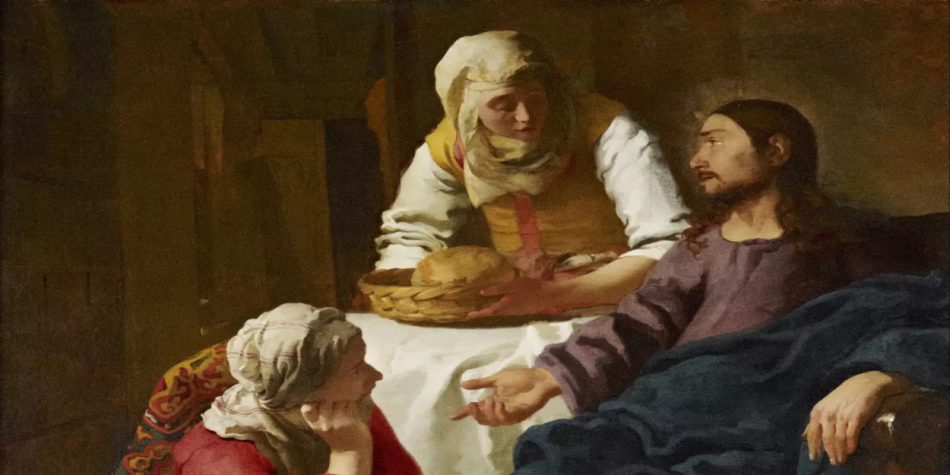Just because some of us have failed, and may yet fail, to live up to what Christ has revealed doesn’t make that revelation false. Christ and his gospel, for instance, do not cease to be inclusive and empowering because some disciples may prove, willfully or not, to be intolerant.
In the specific area of inclusion and empowerment of women, some Latter-day Saints may be like the Ethiopian eunuch in the Book of Acts in that they may lack the tools, including secular ones, that have the potential to illuminate their study and facilitate a greater outpouring of the Spirit. The example of the Ethiopian eunuch also illustrates that although revelation may be hard to understand, the way of the disciple is still to engage it fully and to expect that external help will come to further clarify the revelation. It seems to be in that spirit that President Russell M. Nelson invited the women of the Church in October 2019 “to study prayerfully Section 25 of the Doctrine and Covenants,” in which Christ refers to Emma Smith as “an elect lady.”
President Nelson’s subsequent remarks to the men of the Church in the same sermon suggest that they will also benefit from a greater understanding of Section 25. The contextual and interpretive reading proposed here is not as authoritative as Phillip’s exegetical assistance to the Ethiopian eunuch. I am hopeful, however, that it will help readers come to a greater realization that Section 25 is an innovative, revolutionary revelation in that it reveals a Christ who gives pastoral functions to Emma and, through her, all the women of His church at a time when some were arguing that women should not be allowed to pray or even raise questions directly during worship services.
Of course, there have been previous attempts to contextualize and explicate Doctrine and Covenants 25. I will postulate and argue in particular that Christ continues in Section 25 the dynamic of inclusion and of religious empowerment of women that He had started in the New Testament, and that—for the Saints, at least—he also resolved in the revelation the biblical misunderstanding that was being used in nineteenth-century America to justify the exclusion of women from pastoral functions. Three aspects of the revelation will be considered in support of these claims, namely Emma’s callings (1) as wife, (2) as “elect lady,” and (3) as teacher and exhorter. Ultimately, I will argue that through Doctrine and Covenants 25, Christ establishes Emma as a type and a reflection to show that all women can be empowered and elevated through religious functions in The Church of Jesus Christ of Latter-day Saints. Context is one of the tools needed to understand the profound social and spiritual implications of Doctrine and Covenants 25. Because of that, I will take great care throughout this paper to situate the revelation within the history of the Restoration and the larger history of religion in the United States.
The General Context of Doctrine and Covenants 25
Within the Church, the date of the revelation, July 1830, directs our thoughts to its immediate Restoration framework. The Book of Mormon was published the previous March, and the Church was incorporated in April. This means that Emma, who was baptized toward the end of June, was by today’s standards even a more recent “new convert” compared to those who had been baptized in April. The priesthood power necessary to perform the rituals of baptism and of confirmation had been restored in the months leading to the revelation.
For the larger context, it is safe to assume that the revelation was given when the effects of the “unusual excitement on the subject of religion” Joseph had experienced in the early 1820s were still very much present. As Joseph describes, the religious landscape was very much an open market of preachers from competing religious groups like the Methodists, the Presbyterians, and the Baptists “crying, ‘Lo, here!’ and others, ‘Lo, there!’” and where “great multitudes united themselves to the different religious parties.” The idea of a “free religious market” did not mean the competitors gladly welcomed others and accepted conversion to other churches. The context of the “awakening” of America to God was “bitter in its divisions,” as one historian puts it; in the words of Joseph, it was a context of “bad feeling” and “strife” among the churches. Members of the nascent Church also suffered from this context: for instance, persecutions, which intensified prior to the publication of the Book of Mormon, had delayed the confirmation of Emma and of other people baptized at the same time. The first calling extended to Emma in the revelation is a confirmation of her matrimonial responsibilities toward her husband.
Aside from affiliation, as Joseph indicates, the bitterness and strife covered a broad spectrum of issues including, of course, theology with intense and protracted debates on Christology, the procedures and disciplines of religious life with questions on acceptable forms of worship, and the role women could play, if any at all, in these areas.
A Comfort unto My Servant: When Christ Reconstructs Matrimonial Duties
The first calling extended to Emma in the revelation is a confirmation of her matrimonial responsibilities toward her husband. Christ stipulates that “thy calling shall be for a comfort unto my servant, … thy husband, in his afflictions, with consoling words, in the spirit of meekness.” There is no contesting that matrimony was an important part of that specific calling. Yet, to approach the passage solely in that light might be equated to seeing only “the letter” of the revelation. We might miss its “spirit” and therefore the spiritual implications of the calling if no effort is made to read beyond the obvious fact that with matrimony comes mutual obligations. In fact, the Saints might miss the intent of the revelation should they fail to understand why Christ dwells on what had better be a given in a marital relationship. Who can think that there was no comfort and no consoling words, no meekness or humility in Joseph and Emma’s marital relationship? Did it take the opening of the heavens for them to know about those things? The answer to those questions is a definite no. Nothing in their relationship indicates that Emma, who had already been through a lot of persecutions and had just confirmed her fidelity through her baptism, had given Joseph and the Lord any reason to doubt that she was an affectionate wife. Yet, the Lord gave a revelation on the subject.
Beyond the obvious matrimonial considerations of the revelation then, readers should also engage with the text. A careful and informed reading can, for instance, call attention to the fact that instead of contractual terms like duty and responsibility, the Lord used the word calling. Latter-day Saints are very familiar with this word, which adds an extra layer of significance to matrimony: the term calling has profound spiritual and ecclesial, that is, institutional, implications within Christianity. For instance, after having surveyed Martin Luther’s use of the word calling and its prevalence in Protestantism, sociologist Max Weber came to the conclusion that the word suggests “a God-given mission.” The notion of “vocation” is sometimes used in association with, or as a synonym for, calling. In a religious context, that “vocation,” as used by Luther, becomes a charge that the believer “ought to accept as a divine decree,” “the ‘destiny’ which he must embrace,” or “the mission imposed by God.” This religious understanding of the term continued in Joseph and Emma’s days and in the larger Protestant tradition in America. Whether it was through a dream, a vision, a strong feeling, or a conviction after having listened to a sermon or read a biblical passage, being “called” was always understood to be a divine communication that had the potential to permanently alter the course of life.
In the case of Emma, however, it may be said that the call to comfort and console signaled the application of a divine seal on, and therefore a sacralization of, her matrimonial responsibilities. Indeed, in section 25, providing comfort and speaking words of consolation were no longer temporal or even part of normal intimate activities or signs of affections between husband and wife because Christ turned them into specific assignments within a larger religious project. In this sense, it may be said that by defining marriage and matrimonial duties in more than legal and contractual terms, Christ outlined the principles that would underpin eternal marriage in Doctrine and Covenants 132:7: temporal contracts become religiously efficacious only insofar as they are given divine imprimatur.
Emma’s call further echoes countless scriptural stories where God brings to the fore a person of low social standing and empowers that person to fulfill his plan. This may be illustrated with examples from the Bible and from the Book of Mormon. In Alma 19, for instance, two women, Abish and the Lamanite queen are empowered to “serve the role of Jesus” or to function as Jesus. Abish, who is of the lowest standing as a slave, is identified as “one of the Lamanitish women.” But social standings and power structures are reversed in the story. Because of her previous conversion, Abish “knew that it was the power of God” that was working on King Lamoni and the queen, and she became instrumental in how the spiritual experience ended for everyone involved. Abish extends her hand to “raise [the queen] from the ground,” and the queen goes on to raise the king, and so forth.
The Old Testament story of the widow of Zarephath and Elijah the Tishbite also illustrates someone who is presumably of low social status becoming empowered. We learn in 1 Kings 17 that in spite of Elijah’s immense power to control heaven and earth—including the power to end the drought so that the people, Elijah included, could find sustenance—God instead made Elijah rely on a vulnerable widow for that sustenance. In other words, the widow becomes as vital to the execution of Elijah’s mission as the power he was entrusted with to bind heaven and earth.
Continuing with this line of reasoning, Emma’s call to “be a comfort” can also be read as a disguised call for Joseph. It may indeed be argued that through Emma’s call Christ also intended to teach Joseph about his own vulnerability and the need for him to rely on Emma. Christ’s insistence on the phrase “my servant, … thy husband” can be read as supporting these arguments of the prophet’s vulnerability and need to rely on Emma for assistance. Christ stepped up Emma’s empowerment and inclusion in the pastoral life of His Church.
Of course, by 1830 Emma knew that Joseph was the Lord’s “servant”—else why her baptism?—and that he was her husband. Hence the phrase “my servant, … thy husband” may seem like an unnecessary reminder. One way to make sense of it might be to begin with the form, the very structure of the statement. With the notions of vulnerability and reliance in mind, this structure seems to demonstrate the underlying message that Christ made Emma his human counterpart who—similar to Aaron and Hur’s relationship to Moses, although in a different type of calling—helps steady the prophet. This means then that the callings of Emma and of Joseph were intertwined and interdependent: they were both called by Christ, and it almost seems like Joseph was incomplete, almost not a prophet, without Emma. In other words, they were bound through their respective callings—though not sealed yet—both in temporal, affectionate terms and as links in a chain that serve the purposes of God.
If humility is required of Joseph to rely on Emma, it is a form of asceticism—a spirit of abnegation or self-denial—that was required of Emma to accept to serve God somewhat indirectly, through Joseph. But once again, reading the matrimonial aspect of the revelation in temporal terms is to stay on the surface, assuming that it continued the traditions in which it was given—that is, like most of her contemporaries, Emma was asked to take the back seat in order to facilitate the religious career of her husband. But as will be demonstrated, such a reading is further countered by the calls to be an elect lady and a hymn compiler, calls through which Christ stepped up Emma’s empowerment and inclusion in the pastoral life of His Church.
Emma as “Elect Lady” among Elect Ladies
Along with giving Emma the sacred matrimonial responsibility, Christ calls her “an elect lady.” Emma and the other early Saints were well enough versed in biblical language to know that it was no ordinary thing to be named “elect lady.” The title is used only once in the Bible in a passage from 2nd John that reads, “The elder unto the elect lady and her children.” The Prophet read this passage during the organization of the Relief Society in 1842 to further impress the significance of the title “elect lady” on the mind of the sisters, “to show that respect was then had to the same thing.”
Scholars debate whether the elect lady in the Johannine text refers to one of the congregations of the Church of Christ; or to the Church itself—the Church of Christ or the Church chosen by Christ; (see Rosalynde Welch—2019 Latter-day Saint Theology Seminar). The former possibility is supported by the fact that John points to the existence of a second elect lady in verse 13, which reads, “the children of thy elect sister greet thee” (emphasis added), although this could also refer to the members of another congregation. This second reference occurs in spite of the use of the definite article the in “the elect lady” in 2 John 1:1. This article can either exclude the possibility of other elect ladies or signify that there is a joint or co- elect lady. In support of this idea of one elect lady among several, we may point to Christ’s declaration to Emma in section 25, where He refers to her as an elect lady, not as the elect lady.
Moreover, in the same revelation, Christ expanded the title with the phrase “whom I have called,” which means that an elect lady, in this specific context, is one who is called, chosen, or selected. Joseph further declared to the sisters of the society that the Lord had given Emma the title of “elect lady” because she was “elected to preside,” implicitly over the Relief Society. Hence, tying the proposition of “one elect lady among several” to the prophet’s explanation to the Relief Society, one may fairly conclude that by virtue of her selection, Emma had become the first among the sisters of the society, all of whom were “elect ladies” by virtue of their baptism and membership in Christ’s Church.

















